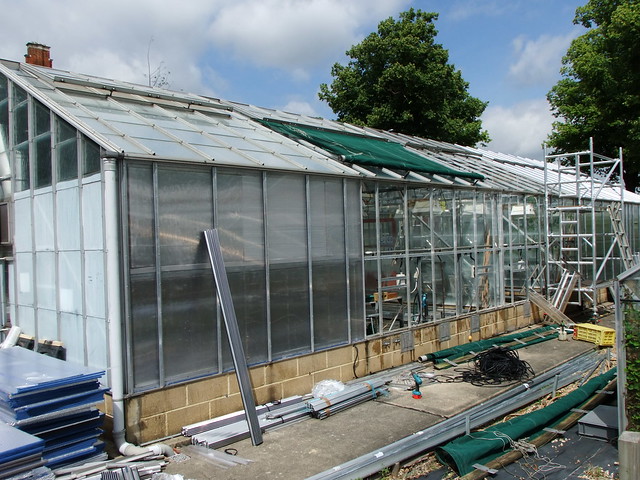Today Charles Whitfield from the Natural Resources Institute tells us about how they are contributing to carbon saving at the University of Greenwich through upgrading and updating the glasshouses and insectary:

Progress on the Glasshouses
Over the last few months the NRI and Facilities Management in conjunction with the University of Greenwich Sustainability Team have made some huge improvements towards reducing energy consumption in our glasshouses and insectaries. The glasshouses were installed over 20 years ago. Although they were built to a very high specification and have lasted well, they have been due for an upgrade for quite some time. The recent refurbishment project has involved:
- Replacing the old 3mm glass panes with tri-walled, high insulating, polycarbonate sheets (24 – 40 % reduction in heating cost). (For the heating geeks, 3mm glass has a U-value of 5.9 and the new polycarb had a value of 3).
- Installing new doors with better insulation and seals.
- Adding light sensors to the hi-lux sodium lamps so that can come on automatically if natural light is too low.
- Removing the FCU heaters from the ceiling which will vastly reduce heat wastage via open ceiling vents as well as allow more natural light into the compartments.
- Upgrading the control systems to link the heating and cooling systems so that they work together (rather than individually as before).
- And finally, preventing the disruption of research and saving precious time and energy, we have replaced all the insect screens to reduce incidences of pest outbreaks in the compartments.
- Improving online BMS access for the glasshouses so they can be monitored and controlled remotely by NRI technicians
At the same time we have also installed new hoses and water guns to reduce water wastage, and work will soon start on repairing and repainting the floors. In addition, the cleaners spent several sweltering days scrubbing 20 years of limescale from the internal glass partitions.


Cleaners working hard at making the glass see through
Energy consumption in the insectaries has been reduced by a number of upgrades to the control systems and ceiling lights. We now have the ability to ‘shut down’ rooms that are not in use. Energy efficient fluorescent lighting has been installed in rooms that originally only had high energy lighting. This allows us to switch over to the energy efficient lighting if the room is not currently being used to grow plants. Not only does this reduce energy consumption by the lights but also reduces the amount of cooling required in the roof space (the high energy lights produce a huge amount of heat). Manual light switches have been added to all the CT rooms in the insectary as well as the EAG room, and post room (so the lights no longer need to be left on all the time).


The finished glasshouses
Overall, these improvements should provide a substantial reduction in energy consumption by the NRI facilities and give users more control of their workspace.






